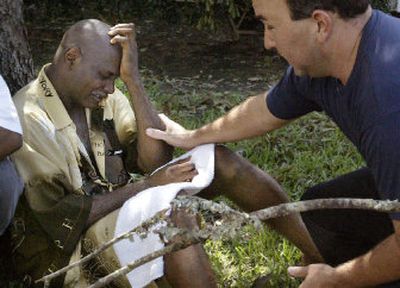Rita evacuees try to pick up pieces

FORKED ISLAND, La. – From a few neighborhoods in New Orleans to the bayous of southwest Louisiana and the oil refinery cities of east Texas, dislocated Americans returned Monday to their homes – and, in many cases, to the hurricane-blasted shells of their lives.
“Half my house is gone,” a visibly shaken David Boudreau said as he drove away from the town of Forked Island in low-lying Vermilion Parish. Hurricane Rita submerged it under a 12-foot flood over the weekend, though the water had receded to some extent by Monday.
In Washington, President Bush said the nation will have to cope with gasoline and other energy shortages for some time. He asked Americans to carpool and curtail nonessential travel, and he signaled that the government again would tap into the Strategic Petroleum Reserve to bolster oil supplies.
“We can all pitch in by being better conservers of energy,” Bush said after a briefing at the Energy Department. “The storms have shown how fragile the balance is between supply and demand in America.”
They also demonstrated some of the dangers of living along the coast, as Americans flock there in ever-greater numbers. More than 87 million people – nearly 30 percent of the U.S. population – now live along the hurricane-vulnerable Atlantic and Gulf coasts, according to the U.S. Census Bureau.
As Rita’s floodwaters receded and rescue crews reached new areas, the storm’s death toll climbed with the discovery of five bodies in an apartment in Beaumont, Texas. Authorities said a man, woman and three children apparently were overcome by fumes from a portable power generator being used indoors.
Rita also was responsible for the deaths of 23 elderly and infirm people trapped Friday in a bus that caught fire as it carried them inland and for two other people, one in Mississippi and one in East Texas.
Many residents returning Monday to Rita’s impact zone found only debris and concrete foundations or mud-caked floors and water-stained walls.
And so, they set to work.
“We just got a new roof,” Juan Jose Plaza said as he swung a hammer-size hatchet against a giant live oak that leaned against his one-story home in Beaumont. It was the second day of his David vs. Goliath battle with that towering slab of nature.
“It makes me feel good to get things clean,” Jamie Lindler said as she delivered trash to a makeshift dump near the Garden District in New Orleans. It was her first day back in a city plundered first by Hurricane Katrina and then by Rita. Authorities permitted limited access to several areas of the city.
Those who reached Houston found little damage and a city humming into action, though hospitals were overburdened and many areas still were without power. Schools and courts will reopen on Wednesday, and bus operations were beginning to approach normal schedules.
But hospitals in Harris and 18 surrounding counties have been treating enormous numbers of patients from east Texas and west Louisiana and were “filled to the gills,” said Dr. David Pursse, Houston’s emergency medical services director.
Houston has one of the largest medical complexes in the world, but some operating rooms have been converted into intensive-care units and waiting rooms have been filled with beds for incoming patients. “One thing Houstonians can do is to judiciously use the hospital,” Pursse said.
Some local officials in Texas lashed out at state and federal authorities, complaining about the pace of relief efforts.
“It’s day four and we’re still struggling for assets,” Jefferson County Judge Carl Griffith said. “I’ve been asking for things and the government has failed again.”
Representatives of the Federal Emergency Management Agency recommended more patience.
“It may not seem like it, but there are a million pieces moving,” said Justin DeMelio, the agency’s local task force leader. “I can’t promise tomorrow will be a whole lot better.”
Across the state line, more than 700 people needed to be rescued from Louisiana’s lowlands, according to state officials and representatives of the Army National Guard, and more await help in areas without electricity and safe drinking water.
In Vermilion Parish, most highways were open, though some stretches remained under several feet of water. Many residents were driving out of the area with backseats full of clothing and trailers full of cattle.
State Rep. Mickey Frith, who represents Vermilion and Cameron parishes, said people had been coming by his store in Abbeville and saying they can’t find their homes.
“They were picked up by the surge or blown away,” Frith said.
At the same time, a spokesman for the National Guard confirmed a report in Monday’s New Orleans Times Picayune that cast doubt on some of the more harrowing accounts of conditions in the city’s Superdome in the aftermath of Katrina.
Despite assertions that 200 people died there, the actual number was six, and four of those people died of natural causes, according to Maj. Ed Bush of the Louisiana Army National Guard. One of the others died of a drug overdose, he said. The other committed suicide.
“What started out as just some casual mistruths blossomed and morphed into scenarios that just were untrue, for example, that we had all these bodies hidden away somewhere,” he said.
“The most frustrating thing and the reason I want to talk about it is that in all that time we never had the violence and the murders and the gangs and the stepping over dead bodies,” he said. “There was just none of that.”